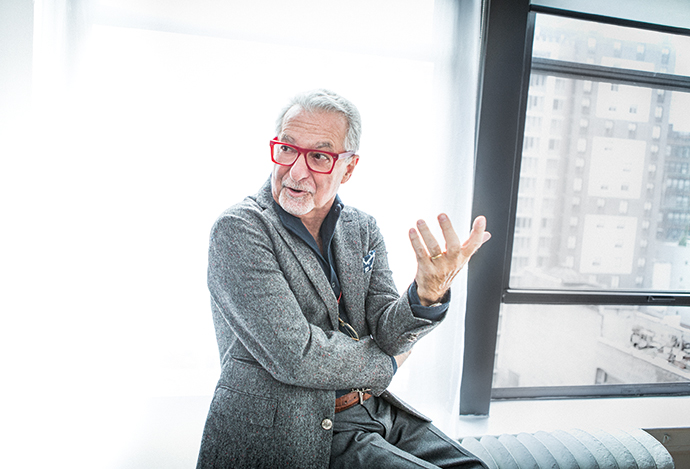Trending
The Closing: Adam Tihany
The star restaurant designer on his Eurotrash days, doing interior work for a Saudi arms dealer, and the “vicious circle” of New York’s sameness

DOB: January 1, 1948
Lives in: Manhattan, Westchester, Paris
Family: Married with a son and a daughter
Adam Tihany founded his eponymous firm in 1978 and has since become a juggernaut in upscale restaurant and hotel design from New York City to Hong Kong. The Transylvania native has led interior work on more than 150 dining establishments and 35 hotels and has been a key designer for seven international cruise ships. The cost of Tihany’s interior projects over the past 40 years totals several hundred million dollars. Tihany recently worked on the $100 million renovation of the Space Needle restaurant in Seattle, the 106-room Four Seasons Resort Dubai and Grant Achatz’s Aviary cocktail bar on Columbus Circle. His most notable restaurant gigs in the city include Thomas Keller’s Per Se at the Time Warner Center, Charlie Palmer’s Aureole on West 42nd Street and Daniel Boulud’s flagship on East 65th Street. Tihany and his wife, Marnie, split their time between homes in Manhattan, Westchester and Paris. Despite being a self-described foodie, his go-to meal when he returns to New York from one of his frequent excursions abroad is a pastrami sandwich.
You were born in Transylvania and grew up in Jerusalem. What was that like? I was not even 3 years old when my parents immigrated to Israel. We got there in 1950, and the country was just starting. We lived the first year in a tent in one of those arrival camps.
Why did you leave Transylvania? Because the communists were coming after my father. He was a staunch Zionist and both my parents were in concentration camps during the war, so when they came back to their hometown my father was actively trying to get the Jews to leave for Palestine.
What did your parents do for a living? My father was a very accomplished attorney in Transylvania after the war. But when he came to Israel, he was doing manual labor, building roads, like everybody else. He had to study the language and redo the bar exam. For years he was studying at night and working during the day. He ended up focusing on reparation law. My mother was selling sandwiches, whatever new immigrants had to do to survive.
How would you describe your childhood? They say that the biggest victims of the Holocaust are probably the survivors and their children — which, in my case, was pretty true. I’m an only child, and they were constantly talking about the concentration camps. It was a horror that never really left them, so my childhood was kind of grueling. Much to my relief, I was drafted into the army at 18, which meant I left home.
What was that like? The Six-Day War happened in the middle of my military service. I spent half of my time in the Suez Canal, in the trenches, and when my military service was over, the only thing that I knew I wanted to do was get out of the country and go study someplace else.
What attracted you to design? Italy was offering to take Israeli students after Israel won the Six-Day War. One of them was Bologna University, where you could study veterinary medicine. The other one was the Politecnico di Milano, where you could study architecture. What I knew about architecture at that time was, basically, I did not want to be a veterinarian. So, I went to Milan in October 1969.
You’re not a fan of animals, then? Not a fan of delivering calves. I like animals, but I don’t like medicine.
Why did you end up sticking with interior work? Italy was poor and there really was no work in architecture per se, so the architects turned their energies to other things. There was this pool of talent that would have otherwise been designing buildings and theaters and stadiums, and they ended up doing ashtrays and glasses and sofas. It was really the birth of contemporary Italian design as the world knows it today. We really were pioneers.
How did you land in the U.S.? In 1972, there was a very important exhibit at the Museum of Modern Art curated by Emilio Ambasz. It was called “The New Domestic Landscape,” and it was the introduction of Italian design to America. The firm I was working for was involved in one of the exhibits, and after it ended, some American firms were looking for Italian designers. Environmental Research and Development [a now-defunct planning and design firm] imported me to start a design division.
How did you make the transition to such high-profile jobs? I worked for ERD for three years and, at the time, was very social and always going to parties.
That was also when a lot of Italians were coming to New York. I found myself in this social group — a milieu of what used to be called Eurotrash. But it was cool. I got to know a lot of these people, and they liked me because I spoke Italian but was a New Yorker. I designed the first showroom for Gianni Versace in the United States, things like that.
Who else did you meet? I met a Venetian decorator named Alessandro Pianon, who said to me, “I have a project in New York, and I need someone to run it for me.” He said there is this Saudi arms dealer by the name of Adnan Khashoggi, and it’s his apartment. It was the largest real estate folly of the time — a 300,000-square-foot apartment with 110 rooms. It had a swimming pool with a waterfall over St. Patrick’s Cathedral. It was insane.
What did you learn from the experience? I became very familiar with interiors, with details, with how these things come together. When the project was finished, I ended up saving $30,000 and I opened my own firm in 1978.
How did you get your first restaurant commission? I was slowly starving, and one night at Studio 54 I sit next to Jean Denoyer, who I had met through my partying days, and he asks, “Do you want to design a restaurant?” I said, “Shit, man, yeah, I’ll design anything. I’m ready to go.” He had the rights to La Coupole in Paris and decided he wanted to build one in New York. Jean was pretty much hands-off, and I got to design the place from top to bottom. I loved it. It opened during a snowstorm in January 1982, and there were lines to get in. The legend goes that Andy Warhol couldn’t get in.
So, you mostly kept your eye on restaurants and hotels after that? I realized by designing restaurants, I can do furniture, interiors, lighting, graphics [logos, menus, signage] and fine china. I suddenly found my Italian-ness. I went out and bought a sign that read: “Adam D. Tihany, Restaurant Designer.”
You’ve also partnered with Daniel Boulud, Thomas Keller, Heston Blumenthal and Jean-Georges Vongerichten. Does that come with a lot of ego management? I’ve been called a portrait artist, a custom tailor. I design for people, not myself. At the end of the day, the strength of the relationship is to keep my ego in check — at a minimum, 10 percent less than the chef’s ego. They have to know it’s about them. They also have to know that not all of them know everything.
It seems every major new development in New York is vying for a celebrity chef. What role does design play in making these restaurants successful? Restaurants have a magical appeal to some landlords. People are willing to make a deal to bring a famous chef to their building because they think it adds value. Celebrity chefs attract the glitterati; they attract a certain clientele. Sometimes it’s very important for a landlord to have that kind of cachet in the building. Deals are not being made on numbers alone.
You recently designed a villa in Dubai, but you don’t do much residential work. Why not? Restaurants open and then you disengage. If you do a house for somebody, it’s for a lifetime. Ten, 20 years later, somebody’s calling you saying, “Hey, schmuck, one of the door handles doesn’t work.”
You’re often credited with creating the title “restaurant designer.” Why wasn’t that already a thing? There was no glory in it. There were certainly talented people designing restaurants, but they didn’t think of it as a profession. Neither did I. I was just tired of people asking me what I do.
Le Cirque on East 58th Street, which you designed in 2005, closed its doors last year because the rent was too high. What was your reaction? Sirio Maccioni and his family are like my family. I’ve designed all of his restaurants, and they are people who are very dear to me. To see that their business has dwindled and ultimately closed was a heartbreak. This isn’t about design, this is really personal. It’s an end of an era for them, and in a way, for me.
Are there any trends in New York design and architecture that you find annoying? Oh, plenty. I think that we are hopefully getting to the end of a period where everything is homespun, exposed bricks, light bulbs with filaments. This should be one of the most sexy, elegant places on the planet. You walk onto Broadway, and it looks like a gathering of 60-year-old college students.
How does that translate to restaurant design? There are phenomenal restaurants in the city. But that extra little glitter isn’t there, because the people don’t care. It doesn’t matter to them that the owner spends $10,000 a month on beautiful flowers. They don’t even see it, which makes the owner say: “Why am I spending it if they don’t appreciate it?” It’s a vicious circle, and I really hope it ends soon. This sameness, this casualness. We are living in the greatest city of the world. Why is it that we don’t behave that way?
—Edited and condensed for clarity.




